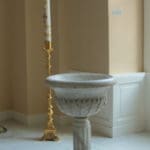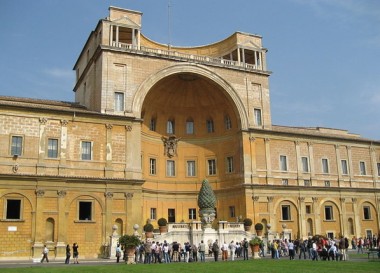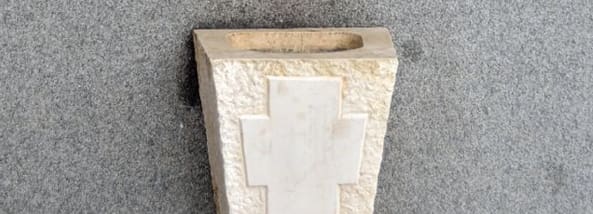Dear Father John, I know we bless ourselves with holy water when we come into Church. Why are ![MortuaryRiedImZillertalStoup[HolyWaterFontCrop]](https://spiritualdirection.com/wp-content/uploads/2014/09/MortuaryRiedImZillertalStoupHolyWaterFontCrop-150x150.jpg) there holy water fonts at the doors of the Church and why do we dip our fingers in them and bless ourselves as we enter? Why did we ever start doing this?
there holy water fonts at the doors of the Church and why do we dip our fingers in them and bless ourselves as we enter? Why did we ever start doing this?
I love this question! So many of the small gestures that we learn early on in our Catholic lives have various levels of meaning. And too often we can simply stay at the level of, “This is just what you do…” I appreciate your frankness and your desire to know more about this simple and beautiful pious practice.
A Baptismal Reminder
 The rich symbolism of this ancient tradition evokes, primarily, three things. First, the blessed holy water reminds us of our baptism. By receiving baptism, we were adopted into God’s family, grace was poured into our souls – we became “temples of the Holy Spirit” (1 Corinthians 6:19). And baptism is administered by the pouring out of blessed water three times, in the name of the Father, of the Son, and of the Holy Spirit. So you can see, when we dip our fingers into the holy water font as we enter a church, and make the sign of the cross over ourselves, we are reconnecting with that mysterious and foundational experience of receiving the sacrament of baptism. By making this reconnection, the Church invites us to thank God, to remind ourselves of our dignity as beloved children of God, and to take comfort in knowing that we truly are members of this divine family, members of the Body of Christ.
The rich symbolism of this ancient tradition evokes, primarily, three things. First, the blessed holy water reminds us of our baptism. By receiving baptism, we were adopted into God’s family, grace was poured into our souls – we became “temples of the Holy Spirit” (1 Corinthians 6:19). And baptism is administered by the pouring out of blessed water three times, in the name of the Father, of the Son, and of the Holy Spirit. So you can see, when we dip our fingers into the holy water font as we enter a church, and make the sign of the cross over ourselves, we are reconnecting with that mysterious and foundational experience of receiving the sacrament of baptism. By making this reconnection, the Church invites us to thank God, to remind ourselves of our dignity as beloved children of God, and to take comfort in knowing that we truly are members of this divine family, members of the Body of Christ.
Purifying the Mind and the Heart
Second, holy water is what the Church calls a “sacramental.” The Catechism defines sacramentals like this (#1667):
Holy Mother Church has, moreover, instituted sacramentals. These are sacred signs which bear a resemblance to the sacraments. They signify effects, particularly of a spiritual nature, which are obtained through the intercession of the Church. By them men are disposed to receive the chief effect of the sacraments, and various occasions in life are rendered holy.
The “effect” that is signified by blessing ourselves with holy water is, basically, cleansing. As we enter the Church and prepare to worship God through the liturgy, we want our minds and hearts to be pure, to be purified from sin and selfishness. This gesture is a way of giving physical and material expression to this desire for repentance and purification. After all, water and cleansing go together even in the natural world. Thus, from the sacramental point of view, the connection is extended into the supernatural plain. You can also express this desire by adding a silent prayer after you make the sign of the cross: “Lord, cleanse me and purify me so that I can worship you and receive you worthily…” This purification helps us focus on God, and focus on praying and worshipping God. That intensified focus opens our souls to receive the grace God wants to send us through the sacramental liturgy. The Catechism has a whole section dedicated to explaining the role of the sacramentals in the life of the faithful. You may find it worthwhile to read it over. You can find it here.
Entering the Sacred Space
Third, locating the holy water fonts at the entrance to our churches symbolizes the difference between ordinary space and sacred space. When we enter into the holy place, we bless ourselves with holy water. We leave behind the worldly noise and confusion that surrounds our normal, everyday activities, and we are refreshed and renewed by the order, silence, reverence, and beauty of the sacred space, the space used only for prayer and worship. The physical experience of feeling the cool, clean holy water on our skin expresses and fosters this spiritual refreshment and renewal. It helps us make the transition from normal business into the special activity of divine worship.
This third symbolic meaning of the holy water fonts was most pronounced in the earliest usages of this tradition. Even in ancient non-Christian religions (including Judaism), ritual ablutions (washings) were frequently an initial step in formal worship. And so, when the first Christian houses of worship were built, the atrium that formed a kind of transition space between the outside, public arena and the church proper, where the liturgy was celebrated, often contained a large fountain. Worshippers would stop at the fountain and bathe their hands and feet (shoes were not as common in ancient times as they are now, at least in the warmer climates) before entering the sacred space. This was a way of preparing themselves, of switching gears, so to speak, in order to be fully attentive during the worship service. As church architecture evolved, so did the fountains. They become holy water fonts, like the ones we are used to today (although many churches still have fountains located in the plazas in front of them, like St. Peter’s Basilica in Rome). When we use them with this in mind, they help us calm and quiet our minds and hearts, leaving aside the hustle and bustle of life in a secular world so that we can enter gratefully into God’s presence.
A Famous Pinecone
 One of my favorite sculptures in the Vatican Museums is a huge bronze pinecone that was part of the fountain in the atrium of the ancient basilica of St. Peter’s, in Rome. (The current basilica is fairly new, being built in the fifteenth and sixteenth centuries, but the first basilica built on that site was constructed in the early fourth century.) In ancient art, pinecones symbolized resurrection and eternal life, because they contained the seeds of new pine trees, just as our current lives as Christians contain the seed of everlasting life. Whenever I see the huge bronze pinecone (and its accompanying bronze sculptures of peacocks, another symbol of the resurrection), I picture the early Christians, my older brothers and sisters in the faith, gathering around it in order to dip their fingers in the holy water and bless themselves with it by making the sign of the cross. It makes me feel connected to all the generations of faithful who have gone before us.
One of my favorite sculptures in the Vatican Museums is a huge bronze pinecone that was part of the fountain in the atrium of the ancient basilica of St. Peter’s, in Rome. (The current basilica is fairly new, being built in the fifteenth and sixteenth centuries, but the first basilica built on that site was constructed in the early fourth century.) In ancient art, pinecones symbolized resurrection and eternal life, because they contained the seeds of new pine trees, just as our current lives as Christians contain the seed of everlasting life. Whenever I see the huge bronze pinecone (and its accompanying bronze sculptures of peacocks, another symbol of the resurrection), I picture the early Christians, my older brothers and sisters in the faith, gathering around it in order to dip their fingers in the holy water and bless themselves with it by making the sign of the cross. It makes me feel connected to all the generations of faithful who have gone before us.
Thank you again for the question. I hope this answer helped. God bless you!
+
Art: Detail of Mortuary Ried im Zillertal Stoup (Holy water dispenser in Reid im Zillertal), Herzi Pinki, 3 January 2013; The baptistery in the Basilica of the National Shrine of the Assumption of the Blessed Virgin Mary in Baltimore, 30 June 2013, own work, Farragutful; La Colossale Pigna [Pinecone], 1506, Uploaded by KevinChanAus, own work, October 2006; all CC Wikimedia Commons.





